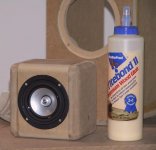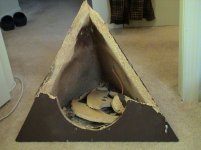I have used two different adhesives when making enclosures in the past, but I have always used screws with it. Now I am making a tiny center channel using two of the Tang Band W3-881s 3 inch full range drivers (one driver with a low-pass to cut out some of the highs, any suggestions?) , so I am using just glue for the first time in my life to avoid splitting the wood or anything.
I have used "Beats the Nail", a thick, pasty stuff before, but it is so gummy after it dries that it makes sanding a bit difficult, I think. Recently I used some very runny Elmers wood glue, and it seemed to work good. Which of these will be more reliable to use by itself with no screws to assist?
Also, any enclosure recommendations for the Tang Bands?
Thanks.
Paul
I have used "Beats the Nail", a thick, pasty stuff before, but it is so gummy after it dries that it makes sanding a bit difficult, I think. Recently I used some very runny Elmers wood glue, and it seemed to work good. Which of these will be more reliable to use by itself with no screws to assist?
Also, any enclosure recommendations for the Tang Bands?
Thanks.
Paul
I am always using standard wood glue rated at 2500 lbs. No screw. Clamp all night and that's all.
http://quicksitebuilder.cnet.com/wrnch2/diyspeakerbuilding/id2.html
Use YELLOW WOOD GLUE.
$2.50 per small bottle.And after even 2 hrs you will not get 2 pieces of MDF apart.
Check out my quick pics of a dato assembly.
Al
Use YELLOW WOOD GLUE.
$2.50 per small bottle.And after even 2 hrs you will not get 2 pieces of MDF apart.
Check out my quick pics of a dato assembly.
Al

I'm using Pattex Profix 200 the clamps can be removed after just 5 minutes. After that it has to harden for 24hours. So you can build very fast without the usage of dozens of clamps.
An externally hosted image should be here but it was not working when we last tested it.
I don't think your box is going to fall apart no matter what you use. But I like to use "liquid nails" that polyurathane thick stuff because it fills in gaps if you have any. I've never tried to take 2 pieces apart that are glued with that stuff, but I have tried to take pieces apart glued with regular wod glue and they never come apart where the glue is. They always take a piece of MDF with them. So both are very strong I'm sure. And both are very hard to sand. And the "liquid nails" stuff I used dries hard.
I think I have tried just about every glue out there at one time or another. So far, the best is just standard yellow wood glue like the type in Brian's picture. It lasts in your bottle longer, is very strong and cleans up with water easily. The poly glues won't last in the bottle well and if you live in a humid area the "swelling" or foaming that occurs from its reaction to water (it's catalyst) actually weakens the joint. You can test this by dampening the joint of two pieces of wood (about bookshelf speaker size), clamp it, and let it set overnight you should see quite a bit of hardened foam at the joint. You should be able to give the pieces a good wack and they will separate at the glue joint. If you try the same test with the yellow glue the wood will break away, not the glue. Several woodworking magazines have tried this and similar tests with like results. The "Liquid Nails" construction adhesive is very strong but doesn't flow well, is much more difficult to clean up, more expensive and doesn't last worth a damn in caulking tubes, even if the tube is new and unopened. The best way to guarantee strong joints is to make sure you have a good fit in your joints. Nice straight and square edges are stronger than swelling glue filled gaps, not to mention better looking. If you decide to build some larger speakers, use biscuits or a locking joint (Tongue and groove, dado, finger joint, etc)to get the most strength from your joints.
Reply to [Kneadle]
That is not MDF, it is definatly chipboard or particle board.
MDF is hard to break,and when it does it breaks cleanly.What I saw was a load of woodchips,sawdust and mess,definatly broken chipboard or partial board.
Anyway I use MDF or plywood, never particle board or chipboard[because this stuff is absolute crap,and flakes off when cutting,and doesn't hold it's shape for years like MDF or plywood.]
Little 'cube' type enclosures for 3 inch drivers,are best made out of MDF or Plywood or real woods,such as Pine,Oak,Beech is you can afford it.
Also although the Tangband drivers looks nice with a silver phase plug,the low sensitivity and poor low wattage of just 15 w rms,makes it a crap driver.
For a 3 inch you don't get much power,but Audax have a 30w rms 3 inch,and Morel have a 60w rms 3 inch,pretty good for the size.
That is not MDF, it is definatly chipboard or particle board.
MDF is hard to break,and when it does it breaks cleanly.What I saw was a load of woodchips,sawdust and mess,definatly broken chipboard or partial board.
Anyway I use MDF or plywood, never particle board or chipboard[because this stuff is absolute crap,and flakes off when cutting,and doesn't hold it's shape for years like MDF or plywood.]
Little 'cube' type enclosures for 3 inch drivers,are best made out of MDF or Plywood or real woods,such as Pine,Oak,Beech is you can afford it.
Also although the Tangband drivers looks nice with a silver phase plug,the low sensitivity and poor low wattage of just 15 w rms,makes it a crap driver.
For a 3 inch you don't get much power,but Audax have a 30w rms 3 inch,and Morel have a 60w rms 3 inch,pretty good for the size.
It might be particle board, but it's definitely not chipboard. It might look like it now that it has been thoroughly destroyed, but this came after hours of trying to make the pieces separate. Honestly, this is the result of 6 hours of painstaking work.
The picture reflects that sort of destruction I wreaked on it and board that is cut at a sharp angle. In addition, the wood shown had already been recycled from some other project.
At any rate, I thought it was MDF. Maybe it's not. Whatever it is is a tragedy.
Dave
The picture reflects that sort of destruction I wreaked on it and board that is cut at a sharp angle. In addition, the wood shown had already been recycled from some other project.
At any rate, I thought it was MDF. Maybe it's not. Whatever it is is a tragedy.
Dave
Bull.
I Put the bang for the money on the TB over your picks any day.
# 1 have you even seen one in your hand.My guess not.
# 2 have you listened to one of the TB 3" in a project MY GUESS NOT.
#3 do some testing of the picks you have said is far better over the TB before you jump the gun.
Having said that I have and have it from very very good source 'S that the TB is a better 3" than any other driver on the market at this time.
On and off axis ,power handling.Sound quality.
And most power ratings are threw a filter.TB specs are not posted after a filter.PURE POWER ratings.
Just a few words of advice.
Al
I Put the bang for the money on the TB over your picks any day.
# 1 have you even seen one in your hand.My guess not.
# 2 have you listened to one of the TB 3" in a project MY GUESS NOT.
#3 do some testing of the picks you have said is far better over the TB before you jump the gun.
Having said that I have and have it from very very good source 'S that the TB is a better 3" than any other driver on the market at this time.
On and off axis ,power handling.Sound quality.
And most power ratings are threw a filter.TB specs are not posted after a filter.PURE POWER ratings.
Just a few words of advice.
Al
I have used both Weldbond and Liquid Nails or similar Polyurethane construction adhesives.
The polyurethane construction adhesives really work well, but I find they are a bit hard to work with, especially if you have a tongue and groove construction. The stuff sticks like anything, but it does not flow well. You have to use a lot of pressure to ensure you get good alignment of the pieces. It is also difficult to clean up
In most cases, I prefer Weldbond. It is a white glue that is exceptionally strong. You use it just like standard wood glue. It cleans up with water, but is waterproof when set.
Alvaius
The polyurethane construction adhesives really work well, but I find they are a bit hard to work with, especially if you have a tongue and groove construction. The stuff sticks like anything, but it does not flow well. You have to use a lot of pressure to ensure you get good alignment of the pieces. It is also difficult to clean up
In most cases, I prefer Weldbond. It is a white glue that is exceptionally strong. You use it just like standard wood glue. It cleans up with water, but is waterproof when set.
Alvaius
- Status
- Not open for further replies.
- Home
- Loudspeakers
- Multi-Way
- Best MDF adhesive, enclosure for Tang Band

